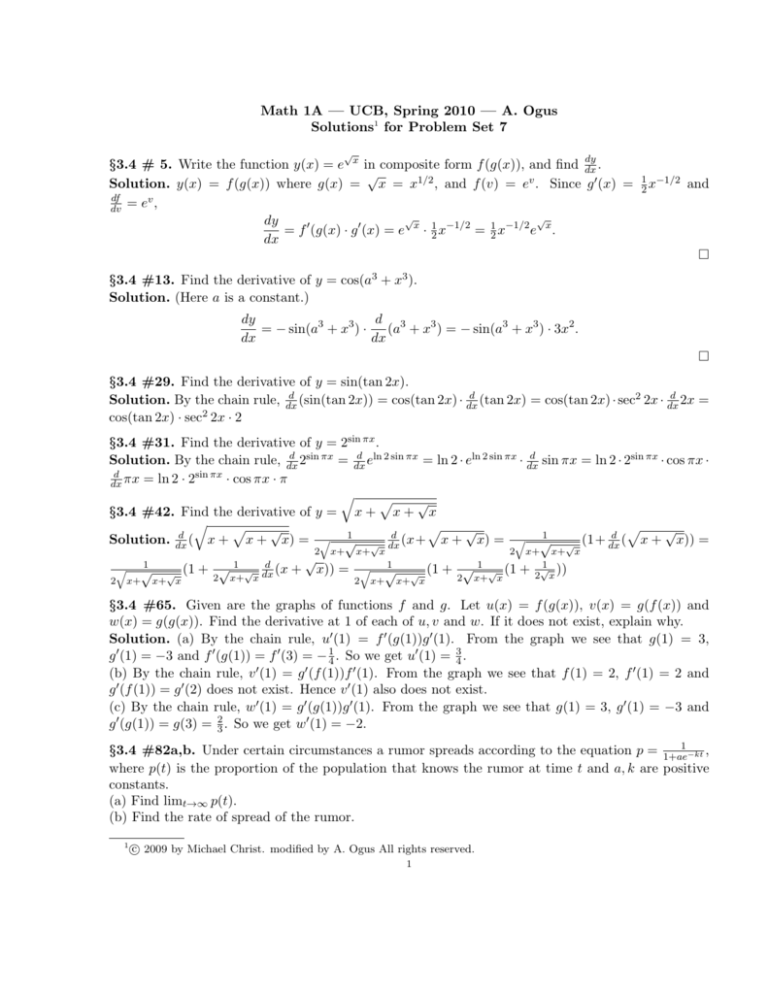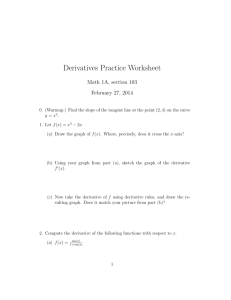
Math 1A — UCB, Spring 2010 — A. Ogus
Solutions1 for Problem Set 7
√
dy
§3.4 # 5. Write the function y(x) = e x in composite form f (g(x)), and find dx
.
√
1/2
v
0
Solution. y(x) = f (g(x)) where g(x) = x = x , and f (v) = e . Since g (x) =
df
v
dv = e ,
√
√
dy
= f 0 (g(x) · g 0 (x) = e x · 12 x−1/2 = 12 x−1/2 e x .
dx
1 −1/2
2x
and
§3.4 #13. Find the derivative of y = cos(a3 + x3 ).
Solution. (Here a is a constant.)
dy
d 3
= − sin(a3 + x3 ) ·
(a + x3 ) = − sin(a3 + x3 ) · 3x2 .
dx
dx
§3.4 #29. Find the derivative of y = sin(tan 2x).
d
d
d
(sin(tan 2x)) = cos(tan 2x) · dx
(tan 2x) = cos(tan 2x) · sec2 2x · dx
2x =
Solution. By the chain rule, dx
2
cos(tan 2x) · sec 2x · 2
§3.4 #31. Find the derivative of y = 2sin πx .
d sin πx
d ln 2 sin πx
d
Solution. By the chain rule, dx
2
= dx
e
= ln 2 · eln 2 sin πx · dx
sin πx = ln 2 · 2sin πx · cos πx ·
d
sin πx · cos πx · π
dx πx = ln 2 · 2
q
p
√
§3.4 #42. Find the derivative of y = x + x + x
q
p
p
p
√
√
√
d
d
d
1
1
q √
(x+
(1+
(
Solution. dx ( x + x + x) = q √
x
+
x)
=
x + x)) =
√ dx
√
dx
2 x+ x+ x
2 x+ x+ x
√
1
1
1
d
1
1
q √
q
√
√
√ dx (x + x)) =
√ (1 + 2√x ))
√ √ (1 +
√ (1 +
2
x+
x+ x
2
x+ x
2
x+
x+ x
2
x+ x
§3.4 #65. Given are the graphs of functions f and g. Let u(x) = f (g(x)), v(x) = g(f (x)) and
w(x) = g(g(x)). Find the derivative at 1 of each of u, v and w. If it does not exist, explain why.
Solution. (a) By the chain rule, u0 (1) = f 0 (g(1))g 0 (1). From the graph we see that g(1) = 3,
g 0 (1) = −3 and f 0 (g(1)) = f 0 (3) = − 41 . So we get u0 (1) = 34 .
(b) By the chain rule, v 0 (1) = g 0 (f (1))f 0 (1). From the graph we see that f (1) = 2, f 0 (1) = 2 and
g 0 (f (1)) = g 0 (2) does not exist. Hence v 0 (1) also does not exist.
(c) By the chain rule, w0 (1) = g 0 (g(1))g 0 (1). From the graph we see that g(1) = 3, g 0 (1) = −3 and
g 0 (g(1)) = g(3) = 32 . So we get w0 (1) = −2.
§3.4 #82a,b. Under certain circumstances a rumor spreads according to the equation p = 1+ae1 −kt ,
where p(t) is the proportion of the population that knows the rumor at time t and a, k are positive
constants.
(a) Find limt→∞ p(t).
(b) Find the rate of spread of the rumor.
1
c 2009 by Michael Christ. modified by A. Ogus All rights reserved.
1
Solution. (a) limt→∞ p(t) = limt→∞
exponent tends to negative infinity.
1
1+ae−kt
=
1
1+limt→∞ ae−kt
=
1
1+0
(b) The rate of spread of the rumor is the derivative of p(t). p0 (t) =
since k is positive and thus the
−(−kae−kt )
(1+ae−kt )2
=
kae−kt
(1+ae−kt )2
§3.4 #83. A particle moves along a straight line with displacement s(t), velocity v(t) and acceleration
dv
a(t). Show that a(t) = v(t) dv
ds . Explain the difference between the meanings of the derivatives ds and
dv
dt .
Solution. We know that the acceleration is the second derivative of s(t). So, a(t) = s00 (t) = (v(t))0 =
dv
dv ds
ds
dv
dv
dt = ds dt = dt v(t) by the chain rule. dt is the rate of change of the velocity relative to time. ds is
the rate of change of the velocity relative to the displacement.
§3.4 #95. If y = f (u) and u = g(x), where f and g are twice differentiable functions, show that
d2 y du 2
dy d2 u
d2 y
= du
2 ( dx ) + du dx2
dx2
Solution. We will first use the product rule, then the chain rule and then another application of the
d2 y
d
d
d
d d
0
0
0
0
0
0
product rule. dx
2 = dx ( dx (f (g(x)))) = dx (f (g(x))g (x)) = g (x) dx (f (g(x))) + f (g(x)) dx (g (x)) =
g 0 (x)f 00 (g(x))g 0 (x) + f 0 (g(x))g 00 (x) =
d2 y du 2
( )
du2 dx
+
dy d2 u
du dx2
§3.5 #11. Find y 0 by implicit differentiation. x2 y 2 + x sin y = 4
d
d
Solution. dx
(x2 y 2 + x sin y) = dx
4
2
dy
d
2
2
2xy + x dx + sin y + x dx (sin y) = 0 by the product rule.
2xy 2 + 2x2 yy 0 + sin y + xy 0 cos y = 0.
y+2xy 2 )
Solving for y 0 gives y 0 = −(sin
.
2x2 y+x cos y
§3.5 #18. Find y 0 by implicit differentiation. tan(x − y) =
Solution. tan(x − y) · (1 + x2 ) = y
dy
d
2
dx (tan(x − y) · (1 + x )) = dx .
(1 + x2 ) sec2 (x − y) · (1 − y 0 ) + 2x tan(x − y) = y 0
2 ) sec2 (x−y)
y 0 = 2x tan(x−y)+(1+x
2
2
1+(1+x ) sec (x−y)
y
1+x2
§3.5 #27. Use implicit differentiation to find an equation of the tangent line to x2 + y 2 = (2x2 +
2y 2 − x)2 at (0, 0.5)
Solution. 2x + 2yy 0 = 2(2x2 + 2y 2 − x)(4x + 4yy 0 − 1)
2 +2y 2 −x)(4x−1)−2x
y 0 = 2(2x2y−8y(2x
2 +2y 2 −x)
y 0 at (0, 0.5) is 2(0+0.5−0)·(−1)−0
=1
1−4(0.5)
The tangent line hence has equation y = x + b for some b ∈ R. Since (0, 0.5) must lie on this line, we
see that b = 0.5. So y = x + 0.5
§3.5 #43. Show, using implicit differentiation, that any tangent line at a point P to a circle with
center O is perpendicular to the radius OP .
Solution. A circle has equation x2 + y 2 = 1. Implicit differentiation yields 2x + 2yy 0 = 0. Assume
first that neither x nor y is zero. So we get y 0 = − xy . The slope of the radius OP is xy . Note that any
two lines of slopes a and b are perpendicular if and only if ab = −1. Thus the tangent line and the
radius are perpendicular. If x or y happen to be zero, we can argue that the same holds by rotational
symmetry, since angles are preserved under rotations.
2
§3.5 #54. Find the derivative of y = arctan(
q
1−x
1+x ).
Solution. tan2 y = 1−x
1+x
Use implicit differentiation: 2 tan(y) · sec2 y · y 0 =
y0 =
−2
(1+x)2
−1
(1+x)2 tan y sec2 y
§3.5 #67. Suppose that f is a one-to-one differentiable function and its inverse function f −1 is also
1
differentiable. Show (f −1 )0 (x) = f 0 (f −1
.
(x))
Solution. Since f and f −1 are inverses, we have that f ◦ f −1 (x) = x. Differentiating both sides with
1
respect to x yields f 0 (f −1 (x)) · (f −1 )0 (x) = 1. Hence (f −1 )0 (x) = f 0 (f −1
. Using the given values,
(x))
we get (f −1 )0 (5) =
1
f 0 (f −1 (5))
=
1
f 0 (4)
=
3
2
since f (4) = 5 implies that f −1 (5) = 4.
§3.6 #9. Differentiate y = sin x ln(5x)
d
1
Solution. dx
(sin x ln(5x)) = cos x ln(5x) + sin x · 5x
·5
√
§3.6 #13. Differentiate y = ln(x x2 − 1)
√
√
d
d
Solution. dx
(ln(x x2 − 1)) = x√x12 −1 dx
(x x2 − 1) =
√
√
2 − 1 + √ x2 ) √x2 −1 = 2x2 −1
√1
(
x
2
2
x(x2 −1)
x x −1
x −1
x2 −1
√1
(
x x2 −1
√
x2 − 1 + x ·
√1
2 x2 −1
· 2x) =
x
1−ln(x−1) and find the domain.
1
)
1−ln(x−1)+x( x−1
ln(x−1)
= 2x−1−(x−1)
. For the
(1−ln(x−1))2
(x−1)(1−ln(x−1))2
§3.6 #27. Differentiate y =
domain, we need to ensure that the
Solution. y 0 =
argument of the ln is positive, i.e. we must have x − 1 > 0, i.e. x > 1. Moreover, we must ensure
that the denominator is not zero, i.e. x − 1 6= 0 and 1 − ln(x − 1) 6= 0, i.e. x 6= 1 and ln(x − 1) 6= 1,
i.e. x 6= e + 1, 1. Thus the domain is {x : x > 1 and x 6= e + 1}
§3.6 #45. Use logarithmic differentiation to find the derivative of y = (cos x)x
Solution. ln y = ln((cos x)x ) = x ln cos x
0
Implicit differentiation yields yy = ln cos x + x cos1 x (− sin x). So y 0 = (cos x)x (ln cos x − x tan x)
§3.7 #5. Given are graphs of the velocity of two particles. When is each particle speeding up?
Slowing down?
Solution. If the velocity is positive, then each particle is speeding up whenever the graph is increasing
and slowing down whenever the graphs are decreasing. If the velocity is negative, the particle is
moving backwards and so it is speeding up whenever the graph is decreasing.
§3.7 #10. If a ball is thrown vertically upward with a velocity of 80ft/s, then its height after t
seconds is s = 80t − 16t2 . What is the maximum height reached? What is the velocity of the ball
when it is 96ft above the ground on its way up and on its way down.
Solution. The maximum height occurs when the ball turns from going up to going down. This
5
happens when the velocity is zero. v(t) = ds
dt = 80 − 32t. This is zero if t = 2 . So the maximum
5
height is s( 2 ) = 200 − 100 = 100, i.e. 100f t. If the ball is 96ft above the ground we have that
96 = s = 80t − 16t2 , i.e. 6 = 5t − t2 i.e. t = 2, 3. So the velocity of the ball at 96ft above ground
when it is on its way up if v(2) = 80 − 32 · 2 = 16, i.e. 16 fst . On it’s way down it has velocity
v(3) = 80 − 32 · 3 = −16, i.e. −16 fst .
3







